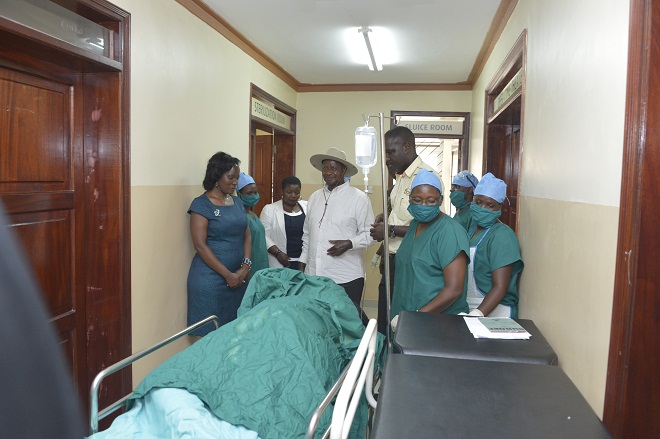I have just been reading the National Population and Housing Census (NHPC) report for 2014. It shows Uganda has registered many welfare improvements, but also reveals that President Yoweri Museveni’s dream of transforming Uganda from an agrarian to an industrial society has not progressed. Let us look at welfare improvements first.
 |
| Museveni visits Mulago. Health is an example of a sector where most say conditions are declining yet outcomes have improved |
Between 2002 and 2014, Infant Mortality Rate has fallen from 87 to 53 deaths per 1,000 live births (39% improvement), Under Five Mortality from 156 to 80 deaths per 1,000 kids (a 48% improvement) and life expectancy at birth has increased from 50 to 63 years. Maternal Mortality has fallen from 550 deaths per 100,000 mothers giving birth in 2000 to 360 in 2014. Malaria prevalence has fallen from 42% to 19% between 2009 and 2015.
Comparatively, only Ethiopia and Rwanda do better than Uganda on most of these health scores in Sub-Saharan Africa. Yet we think Uganda’s health services have become worse. If this perception holds any water, why are health outcomes improving? One could say that failures in public health institutions have been compensated by private healthcare providers.
I would love to embrace this interpretation because it confirms a policy bias I have always articulated i.e. that government should leave healthcare provision to the private sector and restrict itself only to financing. But I have learnt to avoid letting my biases blind me to facts revealed by scientifically generated data. We have a qualitative study by the World Bank on medical competences in Uganda. What does it show?
On vital medical tests like diagnostic accuracy, adherence to clinical guidelines and management of maternal/neonatal complications, the differences between private and public sector providers are statistically insignificant. The private sector is marginally better in drug and equipment availability and much better in infrastructure availability.
If clinical health conditions are declining in Uganda (as we commonly believe) what explains improved health outcomes? Only increasing incomes, improved maternal education and improved nutrition would explain these gains. The alternative explanation would be that it is Jesus Christ, Allah or the spirits of our ancestors who are performing the trick.
The report findings indicate improving delivery of public goods and services on the one hand and increasing household incomes on the other. Regarding public services; in 2002, only 8% of Ugandans had access to electricity. In 2014 that had increased to 20%. Access to improved water sources has grown from 24.8% in 1991 to 60.9% in 2002 and to 71.2% in 2014. School attendance and literacy rates have all dramatically improved.
Regarding household income, while 77.4% lived on rammed earth floor in 2002, only 32.4% did in 2014. Houses whose walls are built of permanent materials have increased from 12% in 1991 to 26.1% in 2002 to 43.7% in 2014. Roofs made of permanent materials were 40% in 1991, 56% in 2002 and 70% in 2014. This shows economic growth has been widely shared.
While these welfare gains are commendable, evidence in the report shows that our country has only made baby steps on the core vision that Museveni has always articulated – structural transformation. This is especially disappointing for a president who has been in power for 30 years.
The 2002 NHPC showed that 78% of Ugandans depended on agriculture for a livelihood; 73% of whom as subsistence farmers. Only 2% of the population depended on industry and 8% on services for a livelihood. The report also showed 87.6% of Ugandans lived in rural areas, 12.4% in urban areas. These are characteristic features of a backward society.
In 2014, there has been little or no change as 79% of Ugandans still live in rural areas and 80% depend on agriculture for a livelihood of whom, 64% are subsistence farmers. Why is our society structurally stagnant? Is it because of Museveni’s mismanagement of the country? Dr. Kizza Besigye would say, “Certainly yes”. Ten years ago I would have agreed.
But I have grown to take research and comparative studies seriously. Sub-Saharan Africa is actually de-industrialising i.e. the share of manufacturing to GDP is decreasing across our vast continent. The only country that has taken manufacturing seriously is Ethiopia. Over the last 15 years and outside of mineral rich countries, it has had the fastest growing economy in Africa, followed by Rwanda. Meanwhile, Vietnam alone has more manufacturing jobs than the whole Africa combined.
If Museveni is the reason Uganda is not industrialising, what explains the entire continent?
If Museveni is the reason Uganda is not industrialising, what explains the entire continent? This means the phenomenon has deep structural roots that are beyond the influence of an individual president and government. In fact, Uganda has enjoyed an impressive rate of economic growth by global standards. As I have written before, over the last 25 years (2013-1989), Uganda has had the 11th fastest growing economy out of 189 nations globally – performing better than the economies of Singapore, Taiwan, South Korea, Mauritius and Botswana, the growth miracles of the 20th century. Yet although this has increased house hold incomes, reduced poverty and improved welfare of many Ugandans, it has not been accompanied by any significant structural transformation. Why?
The problem must be the policy stance Uganda – and most of Africa took; the adoption of private sector-led growth. Policies that encouraged free market competition (of which I have been a chief priest) may have allowed us to achieve short term allocative efficiency. But they have not provided the impetus for the structural transformation that lies at the heart of development.
If Uganda has to undergo structural transformation, it has to have a much more activist state. This means that the state would not only be an adjunct to private enterprise but a transformative agent in its own right. It would be a state that can intervene in the economy to stimulate investment in manufacturing through a selective allocation of long term affordable credit, subsidies and tariff protection of infant industry to private and public institutions.
The problem is that given the high levels of social polarisation in our ethnically diverse society, can this really work? This has been the challenge of postcolonial Africa. The initial postcolonial experiment in state-led industrialisation led to economic collapse. State enterprises became corrupt and inefficient as did private sector beneficiaries of state largesse. I, therefore, think an uncritical embrace of the efficacy of a benevolent state is dangerous. But so is the current blind faith in free markets. What should determine the choice between them requires a much longer debate. So I will return to it another day.
amwenda@independent.co.ug


No comments:
Post a Comment